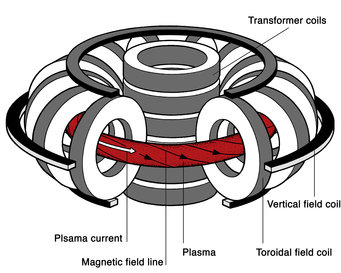
Tokamak
Most of the devices in the world today are of the tokamak type. It is best investigated and comes closest to the ignition conditions.

To construct the magnetic field cage a tokamak requires three superposed magnetic fields: Firstly, a ring-shaped field produced by plane external coils; secondly, the field of a current flowing in the plasma. The field lines of the combined field are then helical. This is what produces twisting of the field lines and formation of magnetic surfaces, which are necessary for confining the plasma. A third, vertical field fixes the position of the current in the plasma.
The plasma current is normally induced by a transformer coil. This is why a tokamak does not work in continuous, but in pulsed mode: In a transformer it is only for a limited time that an increasing current can be generated in the primary winding so that a current can be driven in the plasma. The transformer must, then be "discharged" and the current started up afresh.
In order to achieve steady state operation in a future tokamak power plant, investigations are being conducted on methods of generating current in continuous mode, e.g. by means of high-frequency waves.
